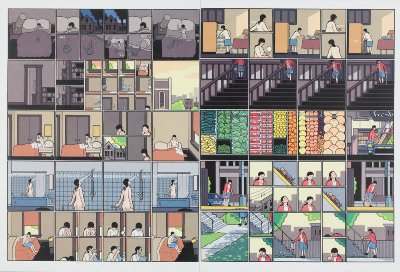Becoming Aware of One’s Own Biased Attitude: The Observer’s Encounter with Disability in Chris Ware’s Acme Novelty Library no. 18
Main Article Content
Keywords
contemporary art, comics, aesthetics of reception
Abstract
This art historical treatment of the graphic novel Acme Novelty Library no. 18 investigates the particular manner of its representation of disability. With reference to theory of body and also theory of images, this study shows that the reading observer is confronted with his/her social and cultural imprint in the process of examining the graphic novel.
Figure 1:

Figure 2:

Figure 3:

Figure 4:

Figure 5:

Figure 6:

Figure 7:

Figure 8:

Figure 9:

Image Credits
Fig. 1. First double page in Acme Novelty Library no. 18, 2007. Montréal (Québec): Drawn and Quarterly n.p. © 2014 C. Ware
Fig. 2. Next double page in ANL no. 18. n.p. © 2014 C. Ware
Fig. 3. Detail of the double page in fig. 2 (right page, n.p.). © 2014 C. Ware
Fig. 4. Marc Quinn. Stuart Penn, 2000. Marble, 160h x 98w x 54d cms, courtesy: Marc Quinn studio
Fig. 5. Marc Quinn. Alison Lapper Pregnant, 2005. Marble, 355h x 180.5w x 260d cms, Trafalgar Square, London. Photo: Marc Quinn studio
Fig. 6. Left page in ANL no. 18. n.p. © 2014 C. Ware
Fig. 7. Right page in ANL no. 18. n.p. © 2014 C. Ware
Fig. 8. Next right page in ANL no. 18. n.p. © 2014 C. Ware
Fig. 9. Next right page in ANL no. 18. n.p. © 2014 C. Ware
References
Clarke, J. J. (2008). Doubly monstrous? Female and disabled. Essays in Philosophy, 9 (1), Article 3, 1–16. Retrieved from http://commons.pacificu.edu/cgi/viewcontent.cgi?article=1289&context=eip
Davis, L. J. (1997). Nude Venuses, Medusa’s body, and Phantom limbs: Disability and visuality. In D. T. Mitchell, & S. L. Snyder (Eds.), The body and physical difference: Discourses of disability (pp. 51–70). Ann Arbor, Michigan: The University of Michigan Press.
Dederich, M (2007). Körper, Kultur und Behinderung. Eine Einführung in die Disability Fink Studies. Bielefeld: Transcript Verlag.
Berman, M. (2010). Imagining an idiosyncratic belonging: Representing disability in Chris Ware’s “Building Stories.” In D. M. Ball, & M. B. Kuhlman (Eds.), The comics of Chris Ware: Drawing is a way of thinking (pp. 191–205). Jackson, Mississippi: University Press of Mississippi.
Garland-Thomson, R. (2000). Staring back: Self-representations of disabled performance Artists. American Quarterly, 52 (2), 334–338.
Garland-Thomson, R. (2006). Ways of Staring. Journal of Visual Culture, 5 (2), 173–192.
Imdahl, M. (1980). Giotto, Arenafresken. Ikonographie, Ikonologie, Ikonik. Munich: Wilhelm Fink Verlag.
Imdahl, M. (1994). Ikonik. Bilder und ihre Anschauung. In G. Boehm (Ed.), Was ist ein Bild? (pp. 300–324). Munich: Wilhelm Fink Verlag.
Klotz, K., Lutz, P., Nürnberg, K., & Walther, S. (2001). IV. Die Mauern. In H. Raulff (Ed.), Der [im]perfekte Mensch. Vom Recht auf Vollkommenheit (pp. 185–198). Ostfildern-Ruit: Hatje Cantz Verlag.
Leader, D. (2000). Sculpture between the living and the dead. In G. Celant (Ed.), Marc Quinn (pp. 14–19). Milan: Fondazione Prada.
Millett-Gallant, A. (2010). The disabled body in contemporary art. New York, NY: Palgrave Macmillan.
Quinn, M. (2006). Fourth plinth. Göttingen: Steidl Mack.
Siebers, T. (2009). Wörter, die uns wie Glasaugen anstarren: Behinderung in Literaturwissenschaft und Visual Studies. In T. Siebers (Ed.), Zerbrochene Schönheit. Essays über Kunst, Ästhetik und Behinderung (pp. 75–88). Bielefeld: Transcript Verlag.
Spector, N. (2002). Nur die perverse Phantasiekannunsnochretten. In N. Spector (Ed.), Matthew Barne:. The Cremaster Cycle (pp. 4–73). Cologne: Museum Ludwig.
Titchkosky, T., & Michalko, R. (2012). The body as the problem of individuality: A phenomenological disability studies approach. In D. Goodley, B. Hughes, & L. Davis (Eds.), Disability and social theory: New developments and directions (pp. 127–142). New York, NY: Palgrave Macmillan.
Wruck, E. (2013a). Hybride Selbstmodellierung in Mattew Barneys The Cremaster Cycle 1994–2002. Kritische Berichte, 41 (1), 127–141.
Wruck, E. (2013b). A sculpture that is made up of moving images, object systems, and still images: Skulpturale Dimensionen des Cremaster Cycle. In C. Hille, & J. Stenzel (Eds.), Cremaster Anatomies. Medienkonvergenz bei Matthew Barney. Bielefeld: Transcript.
Wruck, E. (2014). Matthew Barneys Cremaster Cycle. Narration, Landschaft, Skulptur. Berlin: Reimer.

